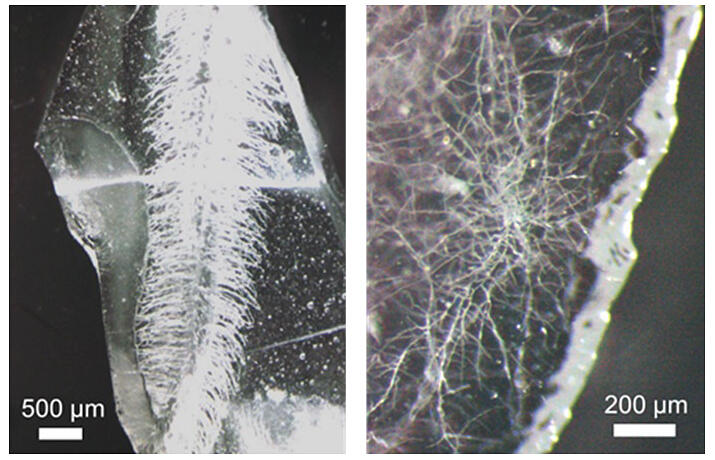Since glass is made of silica, which is abundantly found in natural materials such as sand, it is possible to reproduce microstructures as small as a few microns by cultivating plants and fungi using glass nanoparticles as a culture medium and subsequent sintering. A research group led by Professor Fujio Tsumori of the Faculty of Engineering and Graduate Students Tetsuro Koga and Shota Nakashima (at the time of the study) of the Graduate School of Engineering at Kyushu University, has developed a method of cultivating plants and fungi in a special culture medium containing silica nanoparticles and transcribing their growth patterns within glass as fluid channel structures. Tsumori commented, "This study started out of curiosity about what would happen if we planted seeds in it. The first attempt went well, so we took the project seriously." The research group succeeded in creating a hierarchical channel structure comprising the main root, lateral root, and root hair channels of rye, which were connected continuously even to the hyphae of mycorrhizal fungi symbiotic with the plant roots. The study was published in Scientific Reports.

Provided by Kyushu University
Although the importance of microfluidic channel technology is increasing in the fields of regenerative medicine, environment, and energy, fabrication of complex three-dimensional fine structures like those found in nature has been difficult to achieve using conventional methods. In response to this, the research group turned their attention to a method of growing plants in a silica-based culture medium and subsequent sintering to transcribe their microstructure. However, organic solvents and resin materials are incompatible with plant growth.
Therefore, they prepared a culture medium compatible with plant growth by mixing silica nanoparticles and water with hydroxypropyl methylcellulose (HPMC) as a binder. Another key factor was the availability of silica nanoparticles with good dispersibility in water from Admatechs Co. Ltd. "We grew rye from seeds that I bought at a home improvement store and were able to transcribe the microstructure very nicely," Tsumori said.
Water flow experiments with the resulting glass chips confirmed that water flowed from the main root channel to the root hair channel and even to the channels formed by the mycorrhizal fungal hyphae. The new method is expected to find applications in engineering fields, such as heat exchangers and related microfluidic devices, and tissue engineering. Furthermore, this new method is also effective to observe three-dimensional fine structures by fixing living organisms that are difficult to observe three-dimensionally in soil. Therefore, it is very promising as a new research method to fix and observe in detail the state of the rhizosphere, which constitutes the plant root and hyphal networks.
Journal Information
Publication: Scientific Reports
Title: Replicating biological 3D root and hyphal networks in transparent glass chips
https://www.nature.com/articles/s41598-024-72333-y
This article has been translated by JST with permission from The Science News Ltd. (https://sci-news.co.jp/). Unauthorized reproduction of the article and photographs is prohibited.




